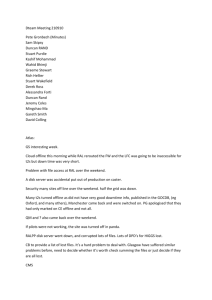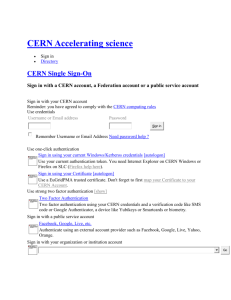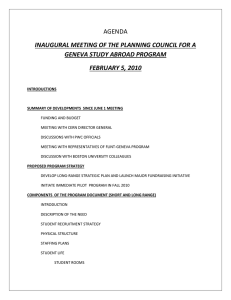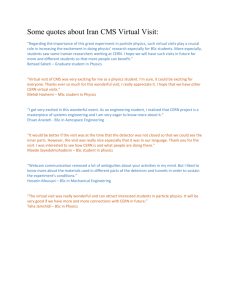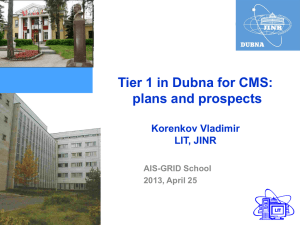EGI_DS Kick-off Meeting WP1 – Project management - Indico
advertisement
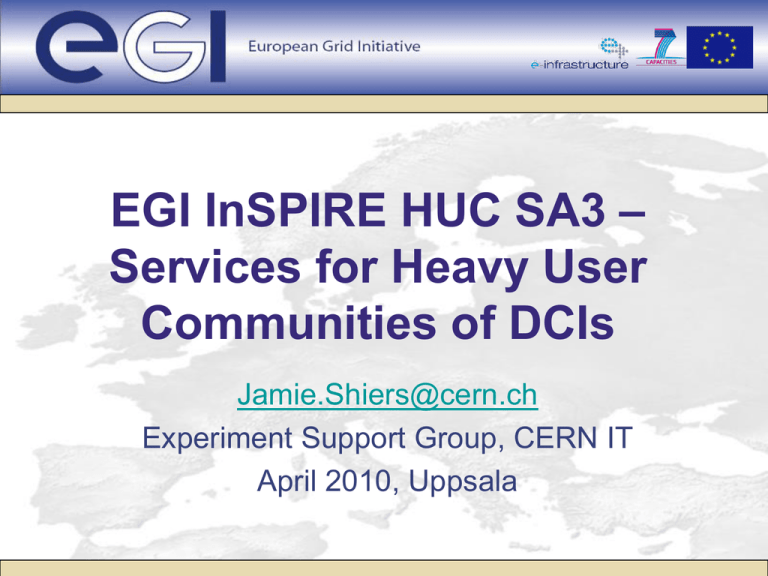
EGI InSPIRE HUC SA3 – Services for Heavy User Communities of DCIs Jamie.Shiers@cern.ch Experiment Support Group, CERN IT April 2010, Uppsala Overview • This talk explains which communities are targeted by the work that is foreseen and outlines mechanisms whereby its progress can be tracked • It examines how the potential benefits – within individual communities, between them (e.g. common tools and services) as well as to the more general DCI community and beyond – can be achieved • Goal: start the discussion – not present a plan 2 Which Communities? • The communities identified as Heavy Users Communities (HUCs) within the EGI InSPIRE proposal are: – – – – High Energy Physics (HEP) Life Sciences (LS) Astronomy and Astrophysics (A&A) Computational Chemistry and Materials Sciences and Technologies (CCMST) – Earth Sciences (ES) – Fusion (F) • There are tools and services that are (typically) of use (today) to more than one community within this set, together with the potential for wider adoption also beyond 1. How to best organize the work amongst these communities? 2. How to maximize benefit to others? 3 Which Tools & Services? • Specific: e.g. Ganga • Frameworks: e.g. dashboard(s) • Generic: workflows / schedulers • Within each of these areas – as well as those not explicitly mentioned – our experience tells us that there can be much to gain from collaboration – But it requires an investment and time to pay off – Several examples of this included as “BACKUP” slides… Services: services for HEP is a significant component (PMs) of this activity This has been an area of major investment / progress over the duration of EGEE I/II/III What can be re-used by other communities? What can be generalized? 4 Milestones & Deliverables What When Report HUC Contact points and the support model (CSC) M: 1 Capabilities offered by the HUCs to other communities (TCD) D: 4 HUC Software Roadmap (INFN) M: 4 Services for High Energy Physics (CERN) M: 4 Training and dissemination event for all shared services (TCD) M: 4 Sustainability plans for the HUC activities (CNRS) D: 9 HUC Software Roadmap (INFN) M: 10 Annual Report on the HUC Tools and Services (CERN) M: 11 Hydra service deployment on a multi-servers configuration (CNRS) M: 12 Integration of the VisIVO server with the production infrastructure (INFN) M: 12 Medical Data Manager release (CNRS) M: 12 5 How to Measure Success? Directly – by agreeing up-front goals and metrics with our communities and evaluating them on a regular (e.g. quarterly) basis – Light-weight community-focused reporting which feeds into EGI QRs (felt useful – even necessary – for HEP…) – WLCG has on-going service reports based on KPIs (initially weekly but now ~twice monthly) & management reporting (quarterly / twice-yearly) Indirectly – by the “impact” this funding is intended to achieve – Also a measure of the above – the supported communities should (preferably) actively acknowledge the contribution(s) to their goals – e.g. “The scientific potential of the LHC” & equivalent And beyond – in terms of timescale & “community” in the sense of Science & Society – Most over-used example is the Web: what has been the value to the global economy and human-kind from this LEP-era development? – A (THE?) key motivation for international and cross-disciplinary funding 6 Sub-activities: HEP • 60PM: Dashboards (Julia Andreeva) • 60PM: Ganga/Diane (Massimo Lamanna) • 200PM: VO services (Maria Girone) +60 PM via INFN • CERN-based activity hosted in IT Experiment Support group – Leader Jamie Shiers, Deputy Maria Girone – (both have specific roles in WLCG Service activities) Regular discussions with LHC computing managers (within the experiments) to agree priorities, assignments, results, future needs etc. • Also CERN + experiments + INFN to ensure overall priorities understood and agreed, in particular for VO services 7 Light-weight Reporting VO / project Purpose Man. Contacts Tech. Contacts Goals SIXT Simulation of particle bunches in LHC Achievements Support requested Time Spent Issues & Concerns … ILD International Linear Detector studies … PARTNER Hadron therapy EnviroGrids Black Sea … ATLAS Main detector / collaboration at LHC … • The sum of the non-LHC + non-HEP VOs supported by “Experiment Support” is quite significant! • Some minimal level of accounting is needed 8 SERVICE ISSUES Some key service issues from the viewpoint of WLCG 9 WLCG – Strengths • Key strengths – that have allowed us to deliver and to adapt – are: 1.The WLCG Operations Model; 2.Personnel – at sites and in the experiments; 3.The Service itself. 10 WLCG Operations Report – Structure KPI Status Comment GGUS tickets No alarms; normal # team and user tickets No issues to report Site Usability (SAM-based) Fully green No issues to report SIRs & Change assessments None No issues to report KPI Status Comment GGUS tickets Few alarms; normal # team and user tickets and/or Drill-down Site Usability Some issues and/or Drill-down SIRs & Change assessments Some Drill-down KPI Status Comment GGUS tickets Many alarms / other tickets Drill-down Site Usability Poor Drill-down SIRs & Change assessments Several Drill-down Normally; Rarely / Never Sometimes; •11 •12 WLCG – Weaknesses • The service is not perfect – it is [ still ] improving but there are a number of problems that clearly characterize it Given our past experience, it does not appear likely that these weaknesses will be solved anytime soon 1. Delays in introducing new services or service versions; 2. Chronic problems – which either come and go or simply persist “for ever” – a cause of much frustration 3. Problems in data / storage management and data access – these deserve a discussion of their own 13 ATLAS Presentation to January WLCG GDB 2010 14 Opportunities (External) • There have been many developments in recent years that have occurred in parallel to the build-up of WLCG • In some cases there is active R&D – or even exploitation – of these technologies / methodologies • We can “ignore” them for a short period – but not forever • And we should not – we have much to benefit from them but the impact may be significant! • The list could include clouds, virtualization, multi-core, storage hardware, filesystems, access protocols, data management techniques, … virtually open-ended! 15 WLCG – Threats (External) Potential Threat Potential Impact (-ve) Funding problems for sites or countries; Resources at sites; Support issues: ROSCOE would have Funding problems for projects (e.g. provided resources at CERN for Experiment ROSOE) Integration & Operations support, Dashboard support and Distributed Analysis Support at several sites (IC, Bham, Oslo, FZU, INFN + non-LHC VOs: FAIR, ILC, …) For CERN alone the loss is 4-5 funded FTEs over 3 years Move from EGEE to EGI & NGIs – many “sub-threats”, e.g. in handling of releases and preproduction, user support, basic operations tools & portals 16 Instability; loss of needed functionality; extra cost (multi-party negotiations?) – complications introduced by distance… We have been preparing for this transition for several years and are “largely” independent… WLCG Service Summary Massive increase in service usage & deployed resources Sum of resources (at any one time) at different tiers ~constant Flat or decreasing support load Sum of tickets at different tiers ~constant Service is now fully delivering: Enabling more & better science; Encouraging and facilitating inter-disciplinary and international collaboration(s); Tangible, long-term benefits to science & society. 17 ATLAS ALICE 1.5 1.7 1.6 1.4 2.1 2.1 1.2 1.1 1.7 1.3 LHCb CMS 4.4 3.3 3.3 4.4 3.1 4.1 4.3 3.2 3.4 3.3 3.2 4.2 4.2 4.2 4.2 4.2 4.5 ATLAS 1.1 ASGC: disk server problem, fixed 1.2 SARA-MATRIX: short scheduled SE downtime 1.3PIC: Transfer errors, SRM down for over 2 hours, more gridftp doors in production solves the problem 1.4 IN2P3: SRM down (a lot of activity during the night). SRM server restarted, OK 1.5 CERN: File transfer problem: failed to contact on remote SRM, caused by a BDII problem, fixed 1.6 RAL: failing transfer attempts, was immediately understood, the file was successfully transferred 1.7 ASGC, IN2P3: SRM tests failures (timeouts) ALICE 2.1 FZK: Temporary SAM Test Failure for VOBOX-User-Proxy-Registration Test CMS 3.1 PIC: file access problem: repeated errors trying to access one file during the 355 rereco preproduction 3.2 RAL, IN2P3: temporary SRM test failures (timeouts) 3.3 KIT, ASGC: MARADONA errors 3.4 CNAF: SRM tests failures LHCb 4.1 GRIDKA: banned for shared area issue. In progress 4.2 Setup the CE-sft-vo-swdir test with a more aggressive operation on the shared area (it does not propagate properly the information of the killing process because running out of time to the final SAM test results (will be fixed soon)) 4.3 IN2P3: restart of the LHCb services running on LHCb VO box due to wrong version of dirac 4.4 Some router instabilities occurred, which could have affected CNAF, IN2P3; network outages on the LHCb ONLINE DB 4.5 PIC: file access test failures: Error in ROOT macro opening/reading the file InSPIRE SA3: Next Steps… • • • Representatives of the different communities – in terms of the services that will be provided through this work-package – need to meet and agree on the above and other key issues Much of this can be virtual: phone, video, collaborative tools, knowledge bases etc, but F2F meetings – planning, reviewing, technical workshops etc. – should also be considered Where possible building on existing commitments / events ?? I guess we will all be going to Amsterdam quite often this year – a good reason to go somewhere else? • I would like to see things happening << summer 2010 – even if some important aspects (grant agreements etc.) may still be underway [ needed for WLCG! ] Use this week! As many formal / informal discussions as possible • Some events are already being discussed around the time of the EGEE III final review: an occasion for a follow-up discussion? (At least amongst the key representatives mentioned above?) 20 Specific Ideas & Plans • Within the HEP community we have ideas and plans for how to move this forward – specifically addressing the needs of our community (LHC-focused) but also collaborations using Ganga, Dashboards and others – These are along the lines of what is discussed above which could be input for wider discussions • Rather than spend time on these here, I would prefer to use most of the remaining time on open issues • Specifically, I would like to ensure that representatives of all of the communities in SA3 meet (immediately after this?) and schedule further discussions and concrete actions – This week and beyond… 21 Looking Further Ahead… • EGI conference in September – assume an SA3 session • WLCG workshop in July – service oriented – possibility to add additional tracks – Cross-fertilization between different disciplines should be a priority • Topical workshops: June on storage and data access; end year / early 2011? 22 Summary • We are at the beginning for a multi-year, multidisciplinary, multi-national project with a strong focus – at least in this WP – on service We have much experience in this domain but still a long way to go… • Collaboration is a proven mechanism for providing solutions that are of wider applicability than those developed within single domains – are typically (much) better for it! 23 BACKUP 24 COLLABORATION – MOTIVATION 25 Collaboration(s) • The CERN Program Library • GEANT4 (RD44) • The (Worldwide) Web CERNLIB • The CERN Program Library is a large collection of general purpose programs maintained and offered in both source and object code form on the CERN central computers. Most of these programs were developed at CERN and are therefore oriented towards the needs of a physics research laboratory. Nearly all, however, are of a general mathematical or datahandling nature, applicable to a wide range of problems. • The library contains several thousand subroutines and complete programs which are grouped together by logical affiliation into several hundred program packages. 80% of the programs are written in Fortran and the remainder in assembly code, or C usually with a Fortran version also available. The language supported is currently Fortran. • Wikipedia entry 27 GEANT4 (né RD44) • Geant4 (for GEometry ANd Tracking) is a platform for "the simulation of the passage of particles through matter," using Monte Carlo methods. It is the successor of the GEANT series of software toolkits developed by CERN, and the first to use Object oriented programming (in C++). • Its development, maintenance and user support are taken care by the international Geant4 Collaboration. • Application areas include high energy physics and nuclear experiments, medical, accelerator and space physics studies. The software is used by a number of research projects around the world. • Wikipedia entry 28 The World Wide Web • Often abbreviated as WWW and commonly known as The Web, is a system of interlinked hypertext documents contained on the Internet. With a web browser, one can view web pages that may contain text, images, videos, and other multimedia and navigate between them by using hyperlinks. • Using concepts from earlier hypertext systems, British engineer and computer scientist Sir Tim Berners Lee, now the Director of the World Wide Web Consortium, wrote a proposal in March 1989 for what would eventually become the World Wide Web.[1] He was later joined by Belgian computer scientist Robert Cailliau while both were working at CERN in Geneva, Switzerland. In 1990, they proposed using "HyperText [...] to link and access information of various kinds as a web of nodes in which the user can browse at will",[2] and released that web in December.[3] • "The World-Wide Web (W3) was developed to be a pool of human knowledge, which would allow collaborators in remote sites to share their ideas and all aspects of a common project." [4] If two projects are independently created, rather than have a central figure make the changes, the two bodies of information could form into one cohesive piece of work. 29 The WLCG Operations Model… • Centred around the daily Operations call at 15:00 Geneva time – These calls started prior to CCRC’08 and have been key to ensuring good information flow, action on tickets and other problems: peer-topeer in all respects • There have been a number of simple optimizations this year: now all experiments provide pre-reports that are pasted into the daily minutes and displayed during the meeting – Comments & site reports added online: meeting minutes typically available by close-of-meeting! Issues at T0/T1/T2 discussed… • Regular reporting using KPIs to Management Board – these reports too have been optimized! – The recently established Tier1 Service Coordination meeting also plays an important role addressing issues on a longer timescale (held every two weeks), such as FTS 2.2.3 roll-out… 30 WLCG Service – The KPIs • Include: 1. Drill-down on any anomalies during the reporting period • E.g. incidents that triggered a Service Incident Report – typically due to an outage or degradation longer (or of the order) of those listed in the MoU (“maximum delay in responding to operational problems”…) 2. Summary of GGUS tickets and drill-down on each and every alarm ticket • Almost all alarms are tests: we compare against the WLCG Critical Service targets in the following table 3. Site Status Reports – using the experiment-specific SAM tests • – 31 Annotated with an explanation of all issues An analysis of Change Assessments – coming from discussion triggered by ATLAS at January GDB Critical Service Follow-up • Targets (not commitments) proposed for Tier0 services – Similar targets requested for Tier1s/Tier2s – Experience from first week of CCRC’08 suggests targets for problem resolution should not be too high (if ~achievable) • The MoU lists targets for responding to problems (12 hours for T1s) ¿ Tier1s: 95% of problems resolved <1 working day ? ¿ Tier2s: 90% of problems resolved < 1 working day ? Post-mortem triggered when targets not met! Time Interval End 2008 Issue (Tier0 Services) Consistent use of all WLCG Service Standards Target 100% 30’ Operator response to alarm / call to x5011 99% 1 hour Operator response to alarm / call to x5011 100% 4 hours Expert intervention in response to above 95% 8 hours 32 Problem resolved 90% 24 hours Problem resolved 99% ATLAS ALICE 0.1 0.1 1.2 1.1 0.2 CMS LHCb 4.2 4.1 0.1 0.3 0.1 4.3 0.2 3.1 0.3 ATLAS ALICE 1.1 1.4 1.2 1.3 0.1 LHCb CMS 3.3 3.2 4.1 3.1 0.1 4.2 4.3 Service Incidents & Change Assessments Site When Issue (as reported in Service Incident Report) CERN 3 Mar Replication of LHCb conditions Tier0->Tier1, Tier0->online partially down (18 hours). Details in next slides Site When Change Assessment & Results CERN 9 Mar update SRM-ATLAS to 2.9, likely rollback • Full Change Assessment here • Summary from IT-DSS & ATLAS viewpoints follows 37


